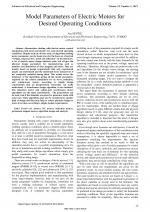| 2/2019 - 4 |
Model Parameters of Electric Motors for Desired Operating ConditionsSEVINC, A. |
| Extra paper information in |
| Click to see author's profile in |
| Download PDF |
Author keywords
computer hacking, computer security, debugging, reverse engineering, software protection
References keywords
motor(16), design(16), synchronous(10), induction(8), permanent(7), magnet(7), rotor(5), applications(5), wound(4), optimal(4)
Blue keywords are present in both the references section and the paper title.
About this article
Date of Publication: 2019-05-31
Volume 19, Issue 2, Year 2019, On page(s): 29 - 36
ISSN: 1582-7445, e-ISSN: 1844-7600
Digital Object Identifier: 10.4316/AECE.2019.02004
Web of Science Accession Number: 000475806300004
SCOPUS ID: 85066314936
Abstract
Researchers dealing with electric motor control simulations need motor parameters for some desired operating conditions. Despite such an obvious need, no algorithm yielding motor parameters can be found even for the basic set of desired /voltage, output power, speed and efficiency/ in the literature. A lot of electric motor design methods exist; but all give the physical design parameters for manufacturing such as numbers and dimensions of slots, magnets and turns. They are usually based on design requirements that only experienced people can understand and the mentioned basic demand set is not completely included among them. This article covers the deficiency of the algorithms giving all the model parameters required for the control simulations for dc servo, induction, and synchronous motors according to simple design requirements that an inexperienced researcher can easily understand. A transformer design algorithm is also included. The induction motor and salient-pole synchronous motor algorithms are the main contributions. The propositions can be used even if the demands are given for generator mode with some care. These algorithms may also be considered as another kind of design and they may help to reduce physical designs to lower-level steps according to simple design requirements. |
| References | | | Cited By |
Web of Science® Times Cited: 1 [View]
View record in Web of Science® [View]
View Related Records® [View]
Updated 3 weeks, 2 days ago
SCOPUS® Times Cited: 2
View record in SCOPUS® [Free preview]
View citations in SCOPUS® [Free preview]
[1] Dependencies of Parameter and Load Toque Sensitivities of Electric Motor Outputs on Design Requirements, Sevinç, Ata, Uluslararası Muhendislik Arastirma ve Gelistirme Dergisi, ISSN 1308-5514, 2024.
Digital Object Identifier: 10.29137/umagd.1411916 [CrossRef]
[2] Two Different Approaches of Applying ANFIS Based MPPT for a PV Water Pumping System with a SEPIC Converter, Miqoi, S., Tidhaf, B., El Ougli, A., Applied Solar Energy, ISSN 0003-701X, Issue 3, Volume 60, 2024.
Digital Object Identifier: 10.3103/S0003701X23601734 [CrossRef]
[3] Model Predictive Control with Active Damping Capability for Induction Machine Driver based on Indirect Matrix Converter, Gokdag, Mustafa, Gulbudak, Ozan, 2020 IEEE Electric Power and Energy Conference (EPEC), ISBN 978-1-7281-6489-2, 2020.
Digital Object Identifier: 10.1109/EPEC48502.2020.9320032 [CrossRef]
Disclaimer: All information displayed above was retrieved by using remote connections to respective databases. For the best user experience, we update all data by using background processes, and use caches in order to reduce the load on the servers we retrieve the information from. As we have no control on the availability of the database servers and sometimes the Internet connectivity may be affected, we do not guarantee the information is correct or complete. For the most accurate data, please always consult the database sites directly. Some external links require authentication or an institutional subscription.
Web of Science® is a registered trademark of Clarivate Analytics, Scopus® is a registered trademark of Elsevier B.V., other product names, company names, brand names, trademarks and logos are the property of their respective owners.
Faculty of Electrical Engineering and Computer Science
Stefan cel Mare University of Suceava, Romania
All rights reserved: Advances in Electrical and Computer Engineering is a registered trademark of the Stefan cel Mare University of Suceava. No part of this publication may be reproduced, stored in a retrieval system, photocopied, recorded or archived, without the written permission from the Editor. When authors submit their papers for publication, they agree that the copyright for their article be transferred to the Faculty of Electrical Engineering and Computer Science, Stefan cel Mare University of Suceava, Romania, if and only if the articles are accepted for publication. The copyright covers the exclusive rights to reproduce and distribute the article, including reprints and translations.
Permission for other use: The copyright owner's consent does not extend to copying for general distribution, for promotion, for creating new works, or for resale. Specific written permission must be obtained from the Editor for such copying. Direct linking to files hosted on this website is strictly prohibited.
Disclaimer: Whilst every effort is made by the publishers and editorial board to see that no inaccurate or misleading data, opinions or statements appear in this journal, they wish to make it clear that all information and opinions formulated in the articles, as well as linguistic accuracy, are the sole responsibility of the author.



